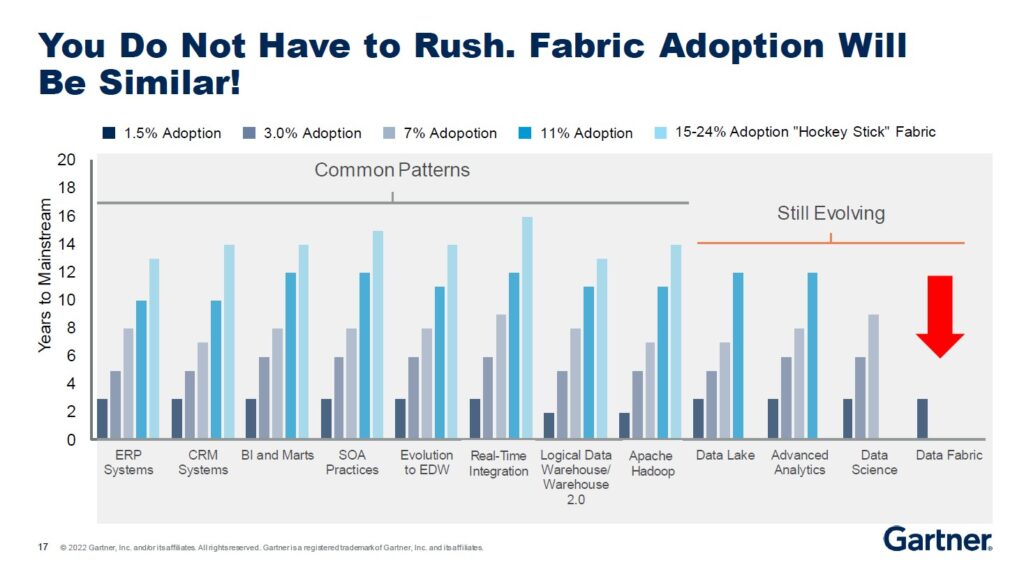
2 Years From Now
My Impressions and Perspectives on the Gartner® Data & Analytics Summit 2022
Contents of the blog series:
- Two Years from Now (Part 1)
- The Rise of Metadata
- Governance is Not a Defensive Play
- Rolling the Sleeves on Metadata/Governance initiatives
These are the themes that resonated with me (presented in various sessions, both by Gartner, partners, exhibitors, case studies):
- By 2025, 80% of organizations seeking to scale digital business will fail because they do not initiate a modern approach to data and analytics governance. [1]
- In the S&P 1200, financial performance is related to the strategic use of D&A. There is a strong positive correlation between the percentage of companies with Low/Medium/High performance to the corresponding percentage of companies with Low/Medium/High D&A mentions in their financial reports.
- According to the Sixth Annual Gartner Chief Data Officer Survey, 72% of D&A leaders are heavily involved or are leading digital business initiatives; these leaders are uncertain as to how they can build a trusted data foundation to accelerate them. [2]
- Data fabric lets the CDO focus on reaching digital business goals by directly addressing many technical data management requirements. [3]
- By 2024, 30% of organizations will invest in data and analytics governance platforms, thus increasing the business impact of trusted insights and new efficiencies. [4]
- 75% of data collected by enterprises remains unused. (CIO.com, March 2022)
- By 2025, active metadata-assisted automated functions in the data fabric will reduce human effort by a third while improving data utilization fourfold. [5]
- By 2024, organizations that adopt aggressive metadata analysis across their complete data management environment will decrease the time to delivery of new data assets to users by as much as 70%. [6]
- By 2022, cloud database management system revenue will account for 50% of total DBMS revenue. [7]
- Early signs of a need to re-engineer decision-making: 75% agree that there is a greater expectation to explain or justify decisions using data. 70% think that the decisions derived from their reports can be automated.
- 95% of decision processes that currently use data, will be at least partially automated by 2025. [8]
- Gartner’s® Risk Opportunity Appetite Return (ROAR) model provides a systematic approach that enables data and analytics leaders to align investments with business priorities, assess their true business value and guide investment decisions. It will identify the highest net business value (business value — capabilities gaps) per dollar spent for a desired strategic business focus target. [9]
These insights and evaluations shared at the Summit, led me to realize that:
- Active metadata improves data literacy, sets organizational social networks, and reveals business patterns faster than data itself.
- Metadata is the key to self-learning and augmented data governance.
- Governance is about control only IF you play defensively.
- To scale analytics self-service, organizations should change from the “don’t share data” mantra to the “must share data unless” model.
Qualitative as well as Quantitative and Actionable
Like my fellow attendees at the Gartner® Data & Analytics Summit 2022 in Orlando, this was my biggest conference since COVID-19 in person, spreading over two big Disney resorts. It was too tempting just to spend time on the exhibit floor and in coffee corners, taking in the reality of what was happening right there in the new and more digital post-pandemic world. That was what I usually did in industry events. Still, I browsed the agenda and was overwhelmed by what I feel is a dramatic change: on the one side, I felt many tracks were dedicated to a very down-to-earth practical execution guide coaching style -”Built for Speed — How to Bootstrap an MDM Initiative” [10]; and, on the other side, a higher percentage of inspirational sessions that touched on decision-making automation, the ability to plan the future under external uncertainty, like society polarization, with practical guides, as did the keynote: Gartner Global Scenarios — How Every D&A Leader Must Sense and Respond to Societal Change. [11]
It seemed to me like the Gartner team made a massive effort to do their research and consulting not only qualitative but also quantitative and actionable.
My impression of the conference was that there was a leading common thread of active metadata management enabling connected governance, allowing better, faster analytics and decision making, with aspirations for future automation. The connection and impact of each of those steps on the business were also referred to.
I will dive deeper into each of those topics in this blog.
Data Fabric
The Summit’s opening keynote had lots of mentions about Active Metadata and Adaptive Governance. I believe we are still very early in the journey of data fabric as a concept and not just a set of tools. Data Fabric is doing more with what you already have. If you have failed, don’t start all over. Data Fabric may make your failures useful.

As Mark Beyer said in his session about the business drivers for data fabric, “Data fabric lets the CDO focus on reaching digital business goals by directly addressing many technical data management requirements.” (Gartner Data & Analytics Summit, Orlando, Florida, 22-24 August, 2022)
In my opinion, what is measurable is manageable. It is only natural to think about data mapping as the first step to understanding what is in the organizational data repository, where it is stored, and how it is used. This is precisely what active metadata does. An abundance of many different types of metadata significantly enhances the probability of success in a data fabric initiative.
The impact is measurable indeed. By 2025, active metadata-assisted automated functions in the data fabric will reduce human effort by a third while improving data utilization fourfold. (See the figure below)
Now imagine the implication on data science and data analysis: the way I interpret the diagram below as: that much more than 80% of analysis resources is spent on finding the right and comprehensive data, something like 90%+. So if we cut the 90% by a third to 60%, we improved analysis and modeling time from 10% to 40% – a scale of 400% in the throughput of analysis capabilities in the organization!

By automating data mapping, the data management challenge for CDOs is solved so they can focus on the business.

To me, offloading data management distractions from business goals is the digital business priority for a data fabric.
So when should you start your data fabric journey?
The answer is ASAP!

As you can see in the diagram, 25% adoption of a technology or a concept is achieved within 16 years, as occurred for all previous tech trends in the last 50 years.
We believe, after 16 years, an innovation cycle starts with a new breakthrough.
The following diagram shows that this adoption has trade-offs with a competitive advantage. By the time of half of the maximum adoption (roughly 12% out of 25%), differentiation levels go down. So, in our opinion even though data fabric is still in its embryonic stage, you should hurry up to enjoy its fruits on time.

Different industries adopt it differently.
Automotive, airplanes, etc., are early adopters. Finance, securities and insurance are the last to go.
We think it is due to the stand-alone nature vs. the convoluted character of the data and analysis models.

In Part 1, we discussed the Data Fabric – what it is, who it is for, and the benefits and timelines for the adoption.
In the next parts of the blog, we will cover Active Metadata, Connected Governance, how to start the ball rolling, and the future of decision-making.
[1] Gartner, “Digital Business Success Needs Adaptive Data and Analytics Governance”, Jan 25, 2022.
[2] Gartner, “Predicts 2022: Data and Analytics Strategies Build Trust and Accelerate Decision Making”, December 2, 2021.
[3] Gartner, “Relating Data Fabric Fundamentals to the Business Drivers”, Gartner Data & Analytics Summit, Orlando, Florida, 22-24 August, 2022.
[4] Gartner, “Connected Governance Drives Adoption of Data and Analytics Governance Platforms”, March 16, 2022.
[5] Gartner, “Top Trends in Data and Analytics, 2022”, March 11, 2022.
[6] Gartner, “Market Guide for Active Metadata Management”, July 27, 2021.
[7] Gartner, “Magic Quadrant™ for Cloud Database Management Systems, December 14, 2021.
[8] Gartner, “Predicts 2022: Data and Analytics Strategies Build Trust and Accelerate Decision Making” December 2, 2021.
[9] Gartner, “How to Optimize Business Value From Data and Analytics Investments … Finally” 3 February, 2022.
[10] Gartner, “Built for Speed — How to Bootstrap an MDM Initiative”, Gartner Data & Analytics Summit, Orlando, Florida, 22-24 August, 2022.
[11] Gartner, “Gartner Keynote: Gartner Global Scenarios — How Every D&A Leader Must Sense and Respond to Societal Change”, Gartner Data & Analytics Summit, Orlando, Florida, 22-24 August, 2022
* GARTNER is a registered trademark and service mark of Gartner, Inc. and/or its affiliates in the U.S. and internationally and is used herein with permission. All rights reserved.




